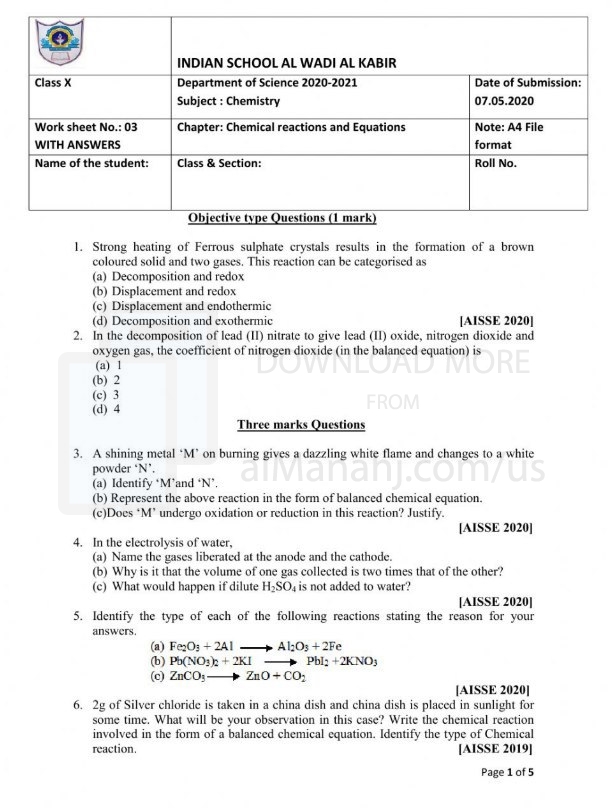| You are here: Almanahj Website ⇒ American curriculum ⇒ 10th Grade ⇒ Chemistry ⇒ Term 1 | ||
|---|---|---|
Worksheet about chemical reactions and equations | ||
|---|---|---|
| Subject: Chemistry | ||
| 10th Grade | ||
| Term 1 | ||
| Year: 2023/2024 | ||
| Size: 750.1KB | ||
| Number of clicks: 156 | ||
| Publish date:November 06, 2023 | ||
| Added by: Eman | ||
| Last download date: 2024-09-10 03:34:29 | By: theodor Jenifer Robinson | |
| File info: Chemical reactions and equations are fundamental concepts in chemistry that describe the transformation of substances into new substances through the rearrangement of atoms. Here is a description of chemical reactions and equations: Chemical Reactions: Chemical reactions involve the breaking and forming of chemical bonds between atoms, resulting in the conversion of reactants into products. Reactants are the starting substances, while products are the substances formed as a result of the reaction. Chemical reactions can occur through various processes, including the transfer of electrons (redox reactions), the sharing or transfer of protons (acid-base reactions), or the rearrangement of atoms (rearrangement reactions). These reactions are governed by the principles of conservation of mass and energy. Chemical Equations: Chemical equations are symbolic representations of chemical reactions. They provide a concise and standardized way of expressing the reactants, products, and stoichiometry of a reaction. A chemical equation consists of reactant(s) on the left side of the equation and product(s) on the right side, separated by an arrow. For example, a simple chemical equation can be represented as follows: Reactant A + Reactant B → Product C + Product D Coefficients are used to balance the equation, indicating the relative amounts of each substance involved in the reaction. Balancing the equation ensures that the number of atoms of each element is the same on both sides of the equation, satisfying the law of conservation of mass. Types of Chemical Reactions: Chemical reactions can be categorized into several types, including: 1. Combination Reactions: Two or more substances combine to form a single product. Example: A + B → AB 2. Decomposition Reactions: A single compound breaks down into two or more simpler substances. Example: AB → A + B 3. Displacement Reactions: An element displaces or replaces another element in a compound. Example: A + BC → AC + B 4. Double Displacement Reactions: Ions exchange between two compounds, resulting in the formation of two new compounds. Example: AB + CD → AD + CB 5. Redox Reactions: Involves the transfer of electrons from one species to another. Example: A + B → A+ + B- (oxidation and reduction) 6. Acid-Base Reactions: Proton transfer occurs between an acid and a base, resulting in the formation of a salt and water. Example: Acid + Base → Salt + Water Understanding and balancing chemical equations is crucial for predicting the outcome of reactions, calculating stoichiometry, and designing chemical processes. It allows chemists to study the quantitative aspects of reactions and provides a framework for understanding the behavior of substances under different conditions. | ||
| Downloading link Worksheet about chemical reactions and equations |
|---|
|
1699248695.pdf
The file is being prepared for download
|
| File images |
|---|
 |